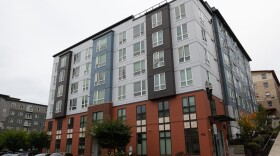On Oct. 21, the Tacoma City Council approved a proposal to expand the city’s camping ban by adding a significant number of areas in which homeless encampments are not allowed.
Council member John Hines, who sponsored the expansion, has said the policy is about keeping public areas open and accessible, but other council members and homeless advocates opposed the move.
The proposal was passed by a 5-4 vote. Hines was joined by colleagues Sarah Rumbaugh, Sandesh Sadalge, Kristina Walker and Mayor Victoria Woodards in voting in favor of the proposal. Council members Olgy Diaz, Joe Bushnell, Jamika Scott, and Deputy Mayor Kiara Daniels voted against it.
“I supported this ordinance because it’s critical that we continue expanding access to services that work — especially our therapeutic courts, which provide meaningful, long-term alternatives for people in crisis,” said Rumbaugh in a statement following the vote. “This is about more than enforcement. We’re investing in low-barrier shelter options, building affordable housing, and working with partners across the region to fill the gaps in our housing system. Public spaces like sidewalks, parks, and school routes need to be safe and accessible for everyone and, at the same time, we are continuing to invest in the resources people need to find stability and support.”
Daniels said she voted against the proposal because the city has not done enough to provide shelter and services for those living unhoused.
“I pride myself on creativity and the culture of ‘yes’ in government, and tonight, I feel like we have failed ourselves, and I cannot get to ‘yes’ in this until we have got to ‘yes’ in the other things,” she said before the vote on the proposal. “We have done so much work in homelessness and so much work in sheltering, and I do not think it is enough to only be a little bit better than the couple of cities next to us.”
In October 2022, the Tacoma City Council passed an ordinance that prohibits camping and the storage of personal belongings in a 10-block radius around temporary shelters and all public property within 200 feet of Tacoma’s rivers, waterways, creeks, streams and shorelines. Under the ordinance, violators face fines of up to $250 and up to 30 days in jail.
Hines’ proposal, made at the beginning of October, amended that ordinance to expand the camping ban to areas within two blocks of public schools, parks and libraries. It also adds buffers around permanent shelters. The amendment would entirely prohibit encampments in the downtown area and the Hilltop neighborhood.
It also will direct that anyone who is cited be referred to the city’s therapeutic court if eligible. Therapeutic courts connect participants with treatment services and community resources instead of traditional sentencing, such as jail or fines.
The proposal was made at a time in which Tacoma’s shelter capacity is at its lowest since the pandemic. In 2025, the city lost nearly 200 shelter beds due to funding shortfalls. The city had about 1,099 shelter beds as of the beginning of 2025 and had 860 by the end of June.
The closure of several shelters also caused the city to lose a number of no-camping buffer zones. According to the city, the city lost five buffer zones from 2024 to 2025 — almost all of which shared overlapping areas in downtown, south and east Tacoma.
Hines said the loss of non-camping buffer zones was the impetus for his proposal, as he had heard from residents that encampments had increased in areas in which buffer zones had lapsed.
Hines said he understands that the ordinance is not intended to address the root causes of homelessness and that he believes more transitional housing and supportive services are necessary to address the crisis.
“Encampments can be unsafe for people and neighborhoods,” he told The News Tribune in an interview earlier this year. “This is meant to address the community impacts of encampments.”
Homeless outreach workers in Tacoma have previously expressed concerns with the city’s encampment removals as they claim the city does not offer enough alternatives for those living unhoused.
“The libraries are the only consistent citywide warming and cooling centers for homeless people,” Sally Perkins, an outreach volunteer in the Hilltop neighborhood, said during public comment before the vote. “Putting them on the camping ban list will make it much harder to convince unhoused people to go there for warming and cooling and will increase the risk the city will confiscate their belongings while inside the library. It will be a bait-and-switch.”
City spokesperson Maria Lee has said that fewer than five citations have been written to enforce the ordinance as of September 2025.
The city has reportedly removed more than 9 million pounds of items from encampments since the original camping ban was passed.
This article was first published by the Tacoma News Tribune through the Murrow News Fellow program, managed by Washington State University.





